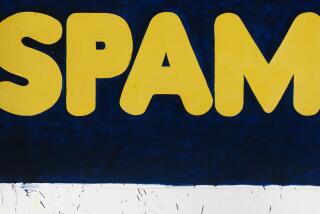A FOCUS ON CHANGES IN COMPLEX EARTHSCAPES
Laurie Brown has focused on the land for years. Unlike the typical landscape photographer, however, she was never satisfied by single, picturesque views of nature. Brown is interested in relationships between one image and another, between past and future cultures, between human beings and the earth. Her latest work, âVistas: Western Journeys,â at the Jan Turner Gallery through Nov. 15, widens the scope to consider the relationship of landscape to earthscape.
Burgeoning construction sites in Brownâs Orange County neighborhood served as a source of subject matter for her early panoramic sequences. Raw land, tracked and scarred by excavation machinery, symbolized human interaction with the earth, implying archeological digs and the building of future artifacts. âI was interested not only in natural changes as they might exhibit themselves in the land, like the layering of the earth building up over time, but also cultural changes,â she explained.
Starting out with hand-colored black-and-white photographs in 1976, she turned to color film after a few years, but always photographed her immediate environment, outdoors and usually within a few miles of her home. âI would go out on the weekends when thereâs nothing happening there and it would be like walking on the moon . . . with those marks and empty expanses of earth and sky.â Grouping the pictures into panoramic sequences was âlike building my own earthwork with photographs.â
âWestern Journeysâ is a significant departure for Brown, literally as well as figuratively. She ventured out to photograph vast expanses of California and Nevada desert, and the mountains and valleys of Arizona, Utah and Idaho. She teamed her images with satellite weather map photographs from the U.S. Weather Service.
âWhen I looked at these satellite weather map images in the newspaper, they gave me a strong sense of being on a planet that existed in space and also being part of the atmospheric conditions that surrounded the planet,â she said. âAnd then I thought of relating that to a specific land site because Iâve always been interested in the way you can connect something very specific to a larger universal idea.â
Current pieces consist of groups of three photographs: a square weather map and a pair of elongated images of the Western landscape made with a Widelux camera. The pair of landscape photographs in each piece are prints made from the same negative, like the two views of a stereographic image. Brown likes the fact that her work is reminiscent of 19th-Century pioneer photographers such as William Henry Jackson and Timothy OâSullivan.
âIn America weâve always thought of the frontier as being the West Coast and the wild Western frontier,â Brown said. âI see now that our frontier has expanded. Itâs no longer the West, but itâs outer space. The NASA and satellite photographs, to me, are the most important photographs that have been taken in the last 20 years--because they have the magic of showing us new horizons; and itâs a new way of thinking about ourselves.â
Visual correspondences between weather maps and Brownâs landscapes let the observer take mental and visual leaps. A cluster of clotted clouds in a satellite picture replicates snowdrifts in a wintery valley. An undulating mountain range echoes the curvature of the earth.
Brownâs new work expands her emphasis on the subtlety and constancy of change in our environment. âTo me,â Brown said, âitâs a very positive feeling to know that weâre part of this whole thing and that our rhythms and our cycles are, indeed, a part of the whole.â
More to Read
The biggest entertainment stories
Get our big stories about Hollywood, film, television, music, arts, culture and more right in your inbox as soon as they publish.
You may occasionally receive promotional content from the Los Angeles Times.










